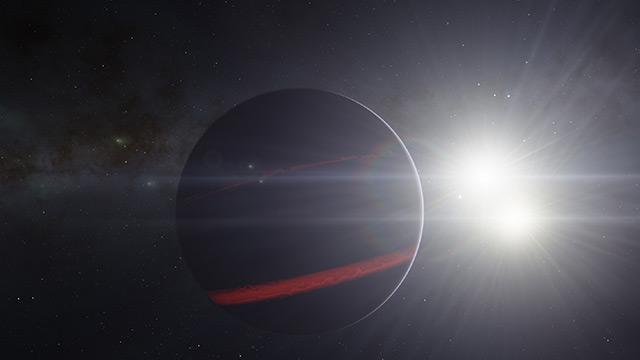
The 50-second audio clip was taken on Juno's flyby of Ganymede on June 7 during the spacecraft's closest approach yet to Jupiter’s moon. This summer, NASA announced that the Juno spacecraft would be flying within 645 miles of Ganymede’s surface, providing a unique opportunity to study the moon.
The audio was taken using Juno's waves instrument, which measures the plasma and radio waves that are detected in the magnetic sphere of Jupiter, a bubble of charged particles that surrounds the planet.
Ganymede is the only moon that has its own magnetic sphere and is the biggest moon in our solar system. Its magnetic fields cause auroras, which are ribbons of glowing electrified gas, at the moon’s north and south poles. It is larger than Pluto and the planet Mercury.
The agency said that it shifted the emissions data that was collected from the moon to an audio range in order to make a recording. As a vacuum, space does not carry sound waves the way the air on Earth does, so the sounds do not actually represent what a human would hear if they visited Jupiter.
The futuristic-sounding results were described by ScienceAlert as “a wonderfully eerie set of alien shrieks and howls,” while others have said it sounds like R2-D2.
Southwest Research Institute and Juno principal investigator Scott Bolton said: “This soundtrack is just wild enough to make you feel as if you were riding along as Juno sails past Ganymede for the first time in more than two decades.”
Scientists are now analyzing the Waves data from the Juno flyby in an effort to determine the meaning of the frequency changes that can be heard in the recording.
He added: "If you listen closely, you can hear the abrupt change to higher frequencies around the midpoint of the recording, which represents entry into a different region in Ganymede's magnetosphere."
Juno is on a mission to unlock the mysteries of the solar system
Juno has been busy collecting data about the origin of Jupiter, a planet so gigantic that 1,300 Earths could fit inside of it. It was launched in 2011 and started orbiting the planet in July 2016. It has recently explored the inside of the planet’s ring and mapped its magnetic field. Although it is the eighth spacecraft to have visited the planet, it is the first one to successfully probe beneath Jupiter’s thick gas cover.
Jupiter is particularly fascinating to scientists given its unique composition. Unlike the other planets in our solar system, it is made of gaseous and liquid elements surrounding a rocky core. Its interior spins every 10 hours and has wind jets that give the planet its distinctive swirls, while its famous Great Red Spot is a type of hurricane that has been raging since the time of Galileo.
According to Bolton, one aim of the Juno project is to gain a deeper understanding of the evolution of other planets and the formation of our solar system. He told The Washington Post: “We’re trying to understand where we came from, how we got here. And Jupiter is a big part of that story.”
Along with the audio recording, the researchers released a new photo taken from inside of Jupiter’s main dust ring, looking out onto the stars, in an image that captured the arm of the Perseus constellation.
NASA Jet Propulsion Laboratory Astronomer Heidi Becker said: "It is breathtaking that we can gaze at these familiar constellations from a spacecraft a half-billion miles away. But everything looks pretty much the same as when we appreciate them from our backyards here on Earth. It's an awe-inspiring reminder of how small we are and how much there is left to explore."
Sources for this article include:
Please contact us for more information.























